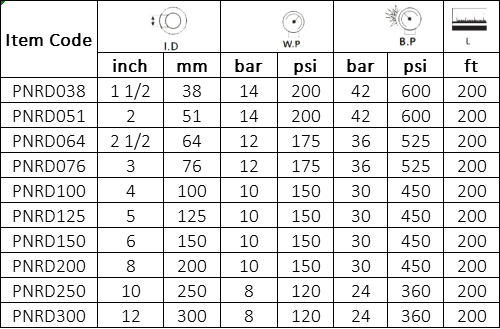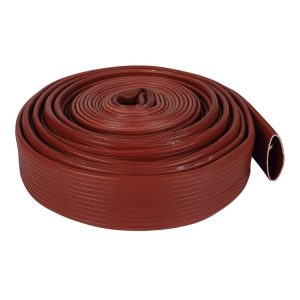Rubber Covered Fire Hose Structure:
Inner and cover: Nitril rubber or TPR
Rinforcement: polyester woven jacket
Rubber covered fire hose has 3 layers, a lining, a reinforce and a cover. The lining and cover are rubber. While the reinforce is polyester woven jacket. As for the lining and cover, they can be various rubbers. But normally they are nitrile rubber or TPR.
The smooth and flexible lining makes the hose resist wear and chemical. While the polyester offers additional strength and makes the hose more flexible. Besides, it offers great pressure resistance. While the rubber cover protects the hose from wear, puncture and UV radiation. Besides, the cover also makes the hose resist kink and twist. Then ensures the hose a long service life.
As for the rubber, you can ask for nitrile rubber or TPR. Nitrile rubber has excellent oil resistance. Thus you can use the rubber covered fire hose to transfer oils.
Rubber Covered Fire Hose Application:
Fire fighting
It’s a good material for water transfer and spray in fire fighting. Because it’s light in weight and flexible, the fire fighter can use it easily. Besides, it provides stable and reliable performance. With types of connectors, it can deal with kinds of fire.
Industrial use
The heavy duty hose is also ideal for factory like steel making and chemical. It can both deliver large volume water for production and prevent the fire. In addition, it can wash and cool the machines.
Agriculture
Such fire hose is also a great material for agriculture as irrigation fire hose. While the function is deliver water from a long distance or deliver animal waste from dairy and other farms. In addition, it can deliver manure and fertilizer because it can bear chemicals.
Marine and offshore
It can transfer water and other agent in case of emergency.
In a word, rubber covered fire hose is a good choice for various industries for fire fighting and water supply.

Features:
● Unique woven construction-Resists kinking stretching and twisting
● Ribbed cover-Provides high resistance to oil, weathering and abrasion
● Handling-Lighter,less bulky,stores in less space than most rubber discharge hoses
Temperature: -29℃ (-20 ℉ ) to 80℃(+176 ℉)



